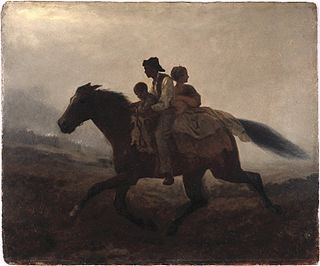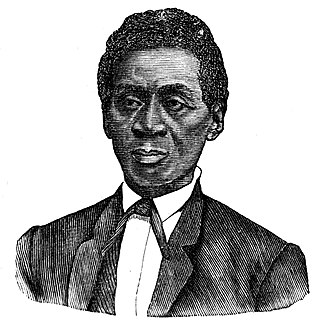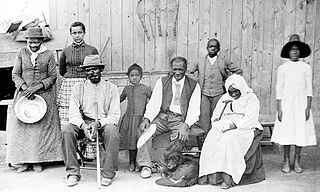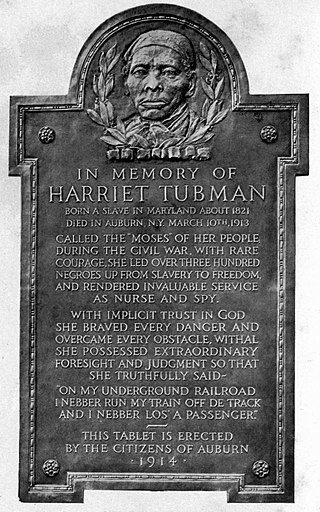Related Research Articles

The Underground Railroad was a network of secret routes and safe houses established in the United States during the early to mid-19th century. It was used by enslaved African Americans primarily to escape into free states and from there to Canada. The network, primarily the work of free African Americans, was assisted by abolitionists and others sympathetic to the cause of the escapees. The slaves who risked capture and those who aided them are also collectively referred to as the passengers and conductors of the "Underground Railroad". Various other routes led to Mexico, where slavery had been abolished, and to islands in the Caribbean that were not part of the slave trade. An earlier escape route running south toward Florida, then a Spanish possession, existed from the late 17th century until approximately 1790. However, the network generally known as the Underground Railroad began in the late 18th century. It ran north and grew steadily until the Emancipation Proclamation was signed by President Abraham Lincoln. One estimate suggests that, by 1850, approximately 100,000 slaves had escaped to freedom via the network.

Harriet Tubman was an American abolitionist and social activist. After escaping slavery, Tubman made some 13 missions to rescue approximately 70 enslaved people, including her family and friends, using the network of antislavery activists and safe houses known collectively as the Underground Railroad. During the American Civil War, she served as an armed scout and spy for the Union Army. In her later years, Tubman was an activist in the movement for women's suffrage.

William Still was an African-American abolitionist based in Philadelphia, Pennsylvania. He was a conductor of the Underground Railroad and was responsible for aiding and assisting at least 649 slaves to freedom towards North. Still was also a businessman, writer, historian and civil rights activist. Before the American Civil War, Still was chairman of the Vigilance Committee of the Pennsylvania Anti-Slavery Society, named the Vigilant Association of Philadelphia. He directly aided fugitive slaves and also kept records of the people served in order to help families reunite.

In the United States, fugitive slaves or runaway slaves were terms used in the 18th and 19th centuries to describe people who fled slavery. The term also refers to the federal Fugitive Slave Acts of 1793 and 1850. Such people are also called freedom seekers to avoid implying that the enslaved person had committed a crime and that the slaveholder was the injured party.

Samuel Green was a slave, freedman, and minister of religion. A conductor of the Underground Railroad, he was tried and convicted in 1857 of possessing a copy of the anti-slavery novel Uncle Tom's Cabin by Harriet Beecher Stowe following the Dover Eight incident. He received a ten-year sentence, and was pardoned by the Governor of Maryland Augustus Bradford in 1862, after he served five years.

Samuel D. Burris was a member of the Underground Railroad. He had a family, who he moved to Philadelphia for safety and traveled into Maryland and Delaware to guide freedom seekers north along the Underground Railroad to Pennsylvania.

Harriet Tubman National Historical Park is a US historical park in Auburn and Fleming, New York. Associated with the life of Harriet Tubman, it has three properties: the Harriet Tubman Home for the Aged, in Auburn; the nearby Harriet Tubman Residence, just across the city/town line in Fleming; and the Thompson A.M.E. Zion Church and parsonage in Auburn. They are located at 180 and 182 South Street and 47-49 Parker Street, respectively. The A.M.E. Zion Church unit is administered by the National Park Service (NPS), and the South Street properties, including a historic barn and a visitor center, are jointly managed and operated by both the NPS and the Harriet Tubman Home, Inc. The church also works with the NPS in park operations. The Harriet Tubman Grave, in nearby Fort Hill Cemetery, is not part of the park.

Harriet Tubman Grave is an historic gravesite located in Fort Hill Cemetery at Auburn, in Cayuga County, New York. The granite gravestone marks the resting place of famed African-American abolitionist and Christian Harriet Tubman, who was born into slavery in Maryland in the United States in 1822.
Milton C. Sernett is an American historian, author, and professor at Syracuse University. He has published many books, articles and book chapters on African American history. His published works in African-American history focus on abolitionism, religion, biographies and the Underground Railroad. He has spent several years studying the anti-slavery movements in Upstate New York, particularly, the life of Harriet Tubman.

Harriet Tubman Underground Railroad National Historical Park is a 480-acre (190 ha) National Park Service unit in the U.S. state of Maryland. It commemorates the life of former enslaved Harriet Tubman, who became an activist in the Underground Railroad prior to the American Civil War. The Harriet Tubman Underground Railroad National Monument was created by President Barack Obama under the Antiquities Act on March 25, 2013. The portion of the monument administered by the National Park Service was later designated a National Historical Park in 2014, and the remainder is managed by the Fish and Wildlife Service as part of Blackwater National Wildlife Refuge.

The Harriet Tubman Memorial, also known as Step on Board, is located in Harriet Tubman Park in the South End neighborhood of Boston, Massachusetts. It honours the life of abolitionist Harriet Tubman. It was the first memorial erected in Boston to a woman on city-owned property.

The Harriet Tubman Underground Railroad Visitor Center is a visitors' center and history museum located on the grounds of the Harriet Tubman Underground Railroad State Park in Church Creek, Maryland, in the United States. The state park is surrounded by the Blackwater National Wildlife Refuge, whose north side is bordered by the Harriet Tubman Underground Railroad National Historical Park. Jointly created and managed by the National Park Service and Maryland Park Service, the visitor center opened on March 10, 2017.

Harriet Tubman's birthplace is in Dorchester County, Maryland. Araminta Ross, the daughter of Benjamin (Ben) and Harriet (Rit) Greene Ross, was born into slavery in 1822 in her father's cabin. It was located on the farm of Anthony Thompson at Peter's Neck, at the end of Harrisville Road, which is now part of the Blackwater National Wildlife Refuge.

Harriet Tubman (1822 – 1913) was an American abolitionist and political activist. Tubman escaped slavery and rescued approximately 70 enslaved people, including members of her family and friends. Harriet Tubman's family includes her birth family; her two husbands, John Tubman and Nelson Davis; and her adopted daughter Gertie Davis.

The Tilly Escape occurred in October 1856 when an enslaved woman, Tilly, was led by Harriet Tubman from slavery in Baltimore to safety in Philadelphia. Historians who have studied Tubman consider it "one of her most complicated and clever escape attempts." It was a risky trip because Tubman and Tilly would not have been able to travel directly from Baltimore to Philadelphia without proof that they were free women. In addition, local slave traders would have recognized strangers. Tubman sought to evade capture by going south, before heading north, and using different modes of transportation over water and land.
The Dover Eight refers to a group of eight black people who escaped their slaveholders of the Bucktown, Maryland area around March 8, 1857. They were helped along the way by a number of people from the Underground Railroad, except for Thomas Otwell, who turned them in once they had made it north to Dover, Delaware. There, they were lured to the Dover jail with the intention of getting the $3,000 reward for the eight men. The Dover Eight escaped the jail and made it to Canada.
William Brinkley was a conductor on the Underground Railroad who helped more than 100 people achieve freedom by traveling from Camden, Delaware, past the "notoriously dangerous" towns of Dover and Smyrna north to Blackbird and sometimes as far as Wilmington, which was also very dangerous for runaway enslaved people. Some of his key rescues include the Tilly Escape of 1856, the Dover Eight in the spring of 1857, and the rescue of 28 people, more than half of which were children, from Dorchester County, Maryland. He had a number of pathways that he would take to various destinations, aided by his brother Nathaniel and Abraham Gibbs, other conductors on the railroad.

A group of 28 enslaved people from Maryland escaped their slaveholders on October 24, 1857. They were a group of two dozen enslaved men, women, and children who fled from Dorchester County, Maryland. Four men joined their group to travel north along the Underground Railroad.

Harriet Tubman (1822–1913) was an American abolitionist and social activist. After escaping slavery, Tubman made some 13 missions to rescue approximately 70 enslaved people, including her family and friends, using the network of antislavery activists and safe houses known as the Underground Railroad. During the American Civil War, she served as an armed scout and spy for the Union Army. In her later years, Tubman was an activist in the movement for women's suffrage.
References
- ↑ Bound for the Promised Land: Harriet Tubman, Portrait of an American Hero, Ballantine (New York), ISBN 0-345-45627-0
- ↑ Clifford, Kate (Apr 2001). "The Saturday Evening Girls: A Progressive Era Library Club and the Intellectual Life of Working Class and Immigrant Girls in Turn-of-the-Century Boston". The Library Quarterly. 71 (2): 195–230. doi:10.1086/603261. JSTOR 4309506. S2CID 141250519.
- ↑ The Assassin's Accomplice: Mary Surratt and the Plot to Kill Abraham Lincoln, Basic Books (New York), ISBN 9781455801909